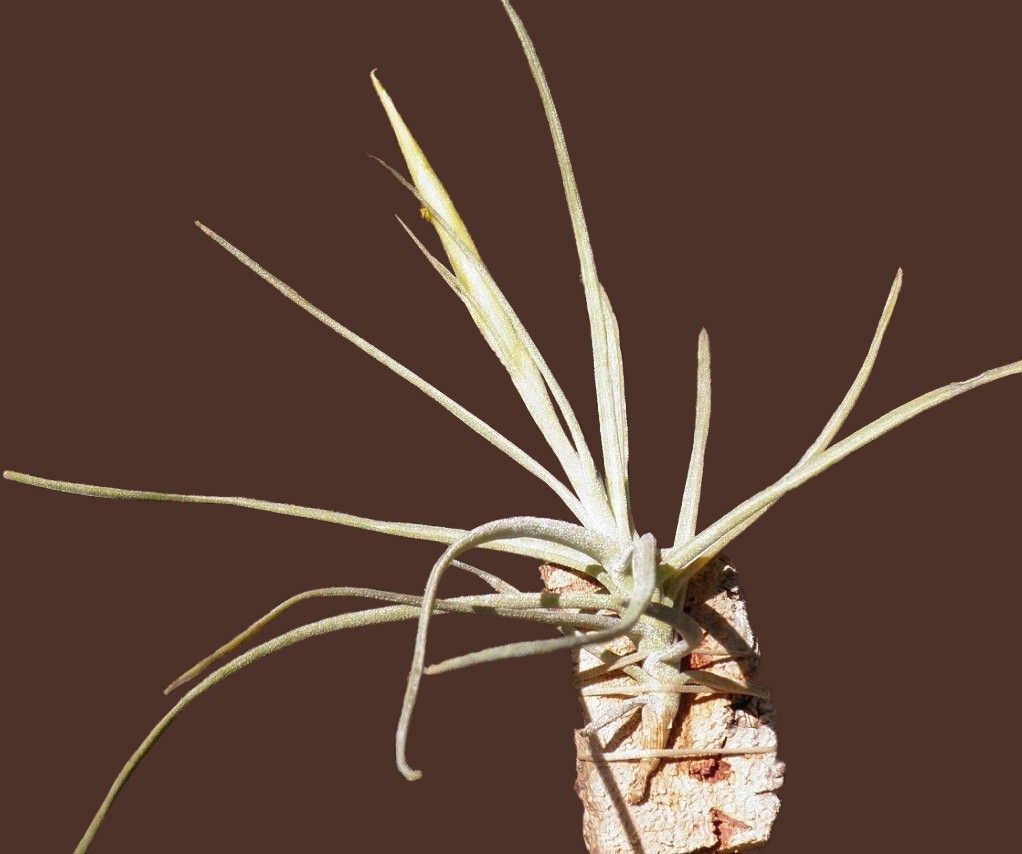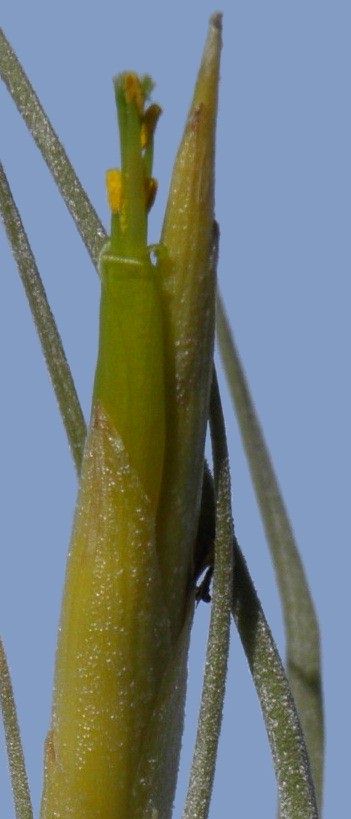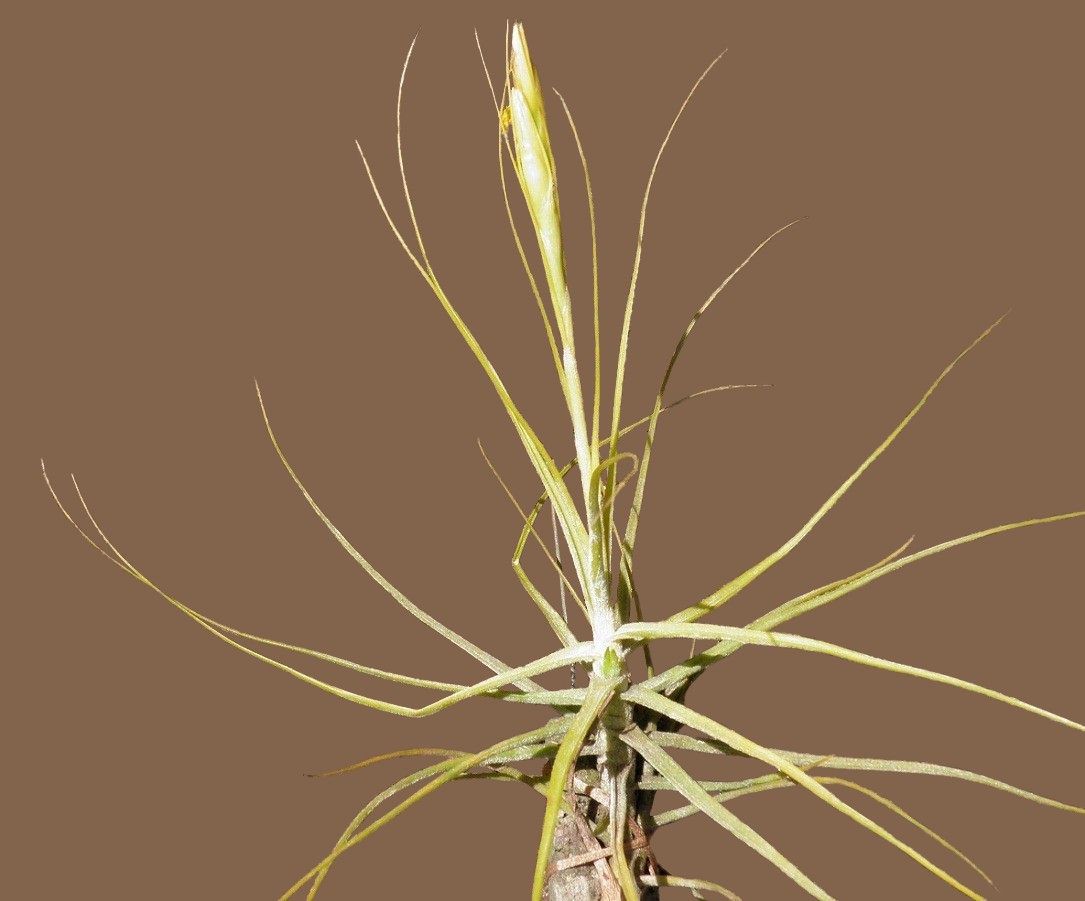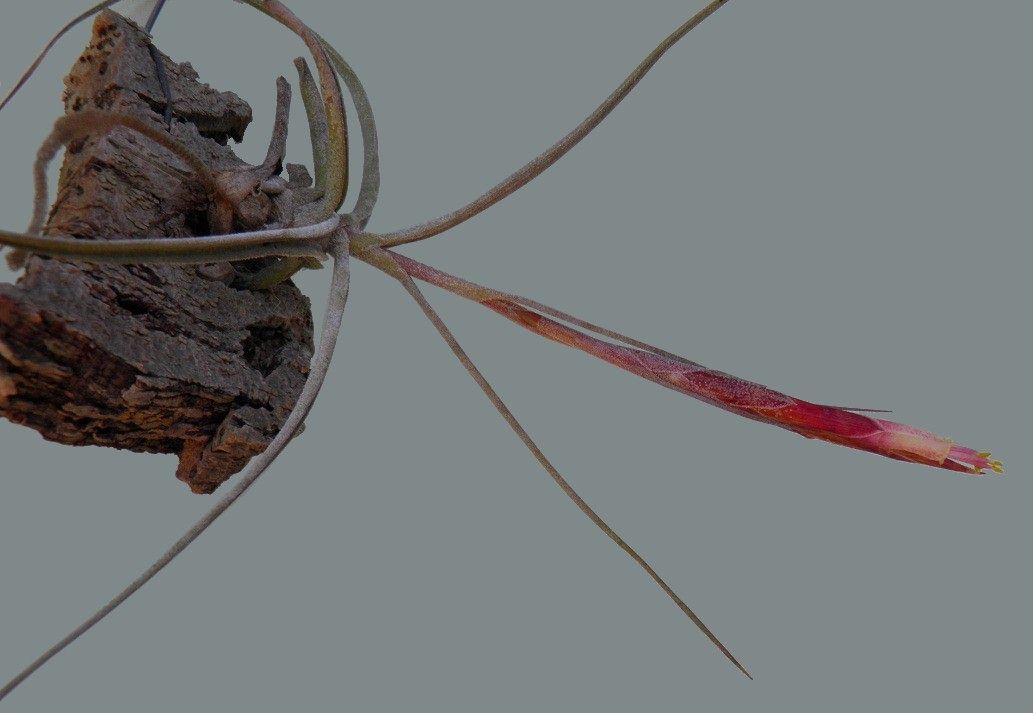






Everybody knows that the ubiquitous T. schiedeana always has yellow petals and reddish tones to its floral bracts - at least this is what all the taxonomists tell us. Because Barry Genn in Qld, Australia, has plants with yellow bracts we both feel they need a cultivar name. There are two forms - thin leafed ( blade 2mm diam at thickest) and fat leafed (blade 5mm diam at thickest). Because they don't blush in the floral bracts they must be ultra shy - hence the two names 'A Little Shy' for the smaller plant and 'Shy' for the larger plant. Apparently Nev Ryan knew about these in the 1990's or before and now Barry has proved that they reproduce faithfully from self set seed.
Renate Ehlers reports that the form with yellow floral bracts is not rare in Mexico, having found it in many locations, most times in low and humid areas. From the taxonomic point of view, details from Smith & Downs are as follows
Tillandsia schiedeana Steudel, Nom. Bot. ed. 2. 2: 688. 1841; ( See L B Smith in Proc. Amer. Acad. Arts 70: 178. 1935, “After being in constant use for over one hundred years, Tillandsia vestita has to be replaced by T. schiedeana because of an earlier homonym.”
Synonyms
Tillandsia flavescens Martens & Galeotti, Bull. Acad. Brux. 10(1): 118. 1843. Type. Jalapa, Vera Cruz, Mexico, Galeotti 4912 (P) 1840.
Tillandsia caerulea sensu Grisebach, Nachr. Ges. Wiss. Gott. "1864": 16. 1865; non Humboldt, Bonpland & Kunth, 1816. Based on Fendler 1533 (K, K photo 7431), Colonia Tovar, Aragua, Venezuela.
Tillandsia grisebachii Baker, Jour. Bot. London 25: 305. 1887; nomen novum for T. caerulea sensu Grisebach.
Tillandsia eggersii Baker, Handb. Bromel. 170. 1889. Type. Llanos de San Rafael, Republica Dominicana, Eggers 1806 (BM, C, GH, K, P, US), 7 May 1887.
Plant caulescent, flowering to 4 dm long, but usually not much more than 2 dm, often pulvinate; stem 5-20 cm long, simple or few-branched.
Leaves polystichous-ranked, varying greatly in density, to 25 cm long, densely cinereous-lepidote or ferruginous-lepidote; scales appressed near the apex of leaf, spreading below;
Sheaths suborbicular, large, densely imbricate and making the stem appear very stout, at least the margin hyaline, glabrous only where covered;
Blades very narrowly triangular, filiform-attenuate, involute-subulate.
Scape terminal, erect, shorter than the leaves;
Scape-bracts imbricate and concealing the scape, the lower foliaceous, the upper thinner and usually roseate but usually with a distinct filiform lamina also.
Inflorescence always simple, distichous or sometimes polystichous at base, lanceolate, attenuate at both ends, terete, to 7 cm long and 8 mm in diameter but often less than half as large, densely few-flowered;
Rhachis nearly straight, slender, strongly sulcate, glabrous.
Floral bracts densely imbricate and wholly concealing the rhachis, twice or thrice as long as the internodes, elliptic-lanceolate, obtuse or the basal ones minutely apiculate, about 30 mm long and 10 mm wide, much exceeding the sepals, membranaceous, roseate, strongly nerved, the lower ones appressed-lepidote, the upper ones often glabrous;
Flowers sessile, to 46 mm long.
Sepals lanceolate, acute, to 20 mm long, subcoriaceous, glabrous, even or few-nerved, the posterior ones carinate and usually much connate;
Petals tubular-erect, yellow;
Stamens and pistil exserted;
Ovary ellipsoid.
Capsule cylindric, to 45 mm long.
Type. Schiede & Deppe 1004 (B, B photo 1249/24; isotype BM), Hacienda de la Laguna, Vera Cruz, Mexico.
DISTRIBUTION. Epiphytic, 50-1800 m alt, Mexico and the West Indies to Colombia and Venezuela.
This shows that this species is wide spread and very variable in plant size and furriness of the leaves but nothing is said that the floral bracts may be greenish-yellow to yellow even in the descriptions of the synonyms. In a way it is odd that you see ‘Major’ and Minor’ in Nurserymen’s lists and yet there appears to be a variation of sizes in the wild. But then conversely no names have been given because of difference in floral bract colour and yet apparently this trait has been noticed in the ‘Trade’.
For this ’Shy’ exercise we will ignore Tillandsia glabrior which has been linked to T. schiedeana in the past, but is said to have reddish petals and different plant shape. BUT it does lead to the next cultivar which we will be calling ‘Speckled Pink’ because the petals are creamish coloured with pink speckles and which has also been referred to me by Barry Genn.
In 2004 the Mexicans promoted this taxon from subspecies level to species level without giving a formal description as to what it should look like! So we are guessing a bit but Gardner did write about differences which are a help in trying to identify our plant. I quote from Selbyana: 361-379. 1983 & Jour. Brom. Soc 37: 163-4. 1987
“Tillandsia schiedeana subsp. glabrior
This is the correct name for an attractive small tillandsia that is well represented in the trade and bromeliad collections around the world. This subspecies occurs in large colonies on perpendicular canyon walls from Tequisistlan to Totolapan in the state of Oaxaca, Mexico at 900 to 1200 meters.
Dr. Lyman B. Smith described this plant originally as T. pueblensis var . glabrior from a few dried specimens in 1958. Without fresh flowers, the plant, with its thick, curved, gray-lepidote leaves and small, simple spike, appears similar to T. pueblensis. In 1983, Wilhelm Weber and Renate Ehlers described this same plant as Tillandsia schiedeana var. totolapensis ( See below) from a living specimen collected in Mexico. Since Dr. Smith's varietal name has precedence it must be conserved even though the species epithet is corrected.
Although this subspecies is more closely related to T. schiedeana than to T. pueblensis, it is distinct from the former by several significant characteristics, most of which are associated with saxicoloy. For example, it forms large clumps of a single clone, and individual rosettes have both long, descending stolons and thick, upwardly secund leaves. These characteristics are often found in saxicolous species including T. pueblensis.
Tillandsia schiedeana subsp. schiedeana is widespread, and occurs from northern Mexico to northern South America. Specimens of this subspecies also occur sympatrically with subsp. glabrior. Specimens of the typical subspecies occur also in saxicolous forms. They do not, however, display modification of the typical spherical clumps of stellate rosettes with straight leaf blades joining the leaf sheath at a 90 degree angle. Similarities in inflorescence characteristics of the two taxa support conspecific classification, however, assignment to different subspecies indicates a greater difference than varietal classification does.
Pigmentation of the flowers varies between and within the two subspecies. A larger amount of red pigmentation is typical of the petals of subsp. glabrior with one-half to all of the petal lobes red, whereas in samples from six populations of the typical subspecies only a few specimens in each were found to have a small amount of red pigment at the base of the primarily yellow petals.”
It will be seen from these field observations that both T. glabrior and T. schiedeana can occur in the same geographical area so that natural hybridising can occur. It would appear that reddish tones appear in T. glabrior but our plant is typical T. schiedeana with its leaves spreading at a 90 degree angle and ‘Speckled Pink’ should, if anything, be linked to this species.






